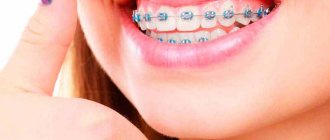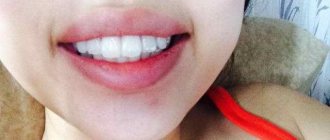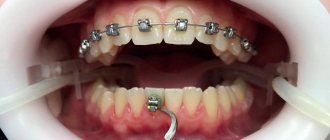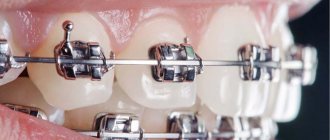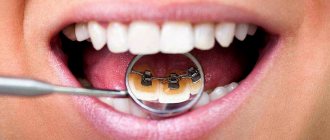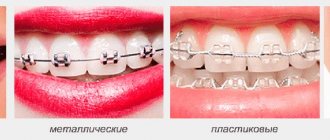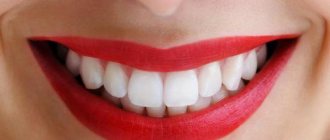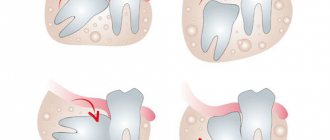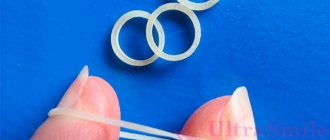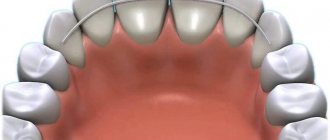Not every patient knows what a combined bracket system is. As a rule, treatment with braces is presented within the framework of the choice of one type of structure. Now you can learn in detail about the combined braces system and, perhaps, reconsider your views on correcting your bite.
A certain percentage of people consider these designs to be optimal for correcting occlusion in terms of price, quality and aesthetics. Speaking about the latter, one cannot help but notice that most often patients try to hide the presence of braces on their teeth as much as possible, sometimes agreeing to lingual braces, which cause a number of serious difficulties in everyday life.
Surely you know that braces are made from different materials. Each of them has a different impact on teeth, strength and appearance. Materials and prices vary. Most often you have to choose between the effectiveness of the treatment and the beauty of your smile, even during treatment. But how to combine the invisibility of transparent braces and the effectiveness of metal ones? More on this later.
Combined braces: indications for installation
Combined braces are selected according to indications:
- Finding a compromise between aesthetics and functionality. It has been proven that metal braces guarantee the maximum effectiveness of treatment, but they are the most unaesthetic and stand out on the teeth. In order not to spoil the beauty of a smile with metal locks, doctors select a different type of brace system for the front teeth, leaving metal for invisible areas.
- Selection for malocclusion pathology. Often, only one jaw needs strong correction—the upper or lower. The second requires less intensive treatment. In this case, doctors recommend installing different orthodontic systems on the upper and lower teeth, which allows you to combine materials or types of devices.
- Patients' financial wishes. Metal structures are not only the most effective, but also inexpensive. Sapphire and lingual braces cost significant amounts. Combining options allows you to save money, get an aesthetically pleasing result during the correction period, and achieve bite correction in a short time.
If we consider strictly the medical indications for installing combined braces, then among them will be:
- pathological bite - open, distal, mesial, deep;
- disproportionate development of the jaws;
- diastemas, trema, large interdental spaces;
- dystopia, incorrect position of individual teeth in the jaw.
Unpleasant moments after installation
Despite all the advantages of such braces, they, like all other orthodontic structures, involve some unpleasant moments after installation.
Almost everyone who has ever been interested in the possibility of getting straight teeth knows about this today. During the consultation, the doctor will once again remind the patient about possible inconveniences during bite correction. Almost everyone experiences discomfort in the first days and weeks after installation. This is due to the unusual constant load and pressure on the teeth that braces exert. Therefore, there is no need to be afraid of an unpleasant moment: the discomfort will pass on its own.
There is also a risk of inflammation of the mucous membrane upon contact with braces and friction, but this can also be solved. Problems with diction are also easy to fix. In general, after a month, all patients get used to braces and stop noticing them.
Combined braces: metal-ceramics and other types
In the photo, combined braces are a combination of metal with ceramics or sapphire clasps. In fact, there are very different combinations. The most popular and in demand among patients:
- Combined metal and ceramic braces. According to pediatric dentists, the optimal combination of materials. Ceramics do not withstand heavy loads well, which justifies its use for front teeth. Metal braces do an excellent job of basic correction, quickly and accurately correcting the bite.
- Combined bracket system made of metal and sapphires. More expensive than the previous option, but even more aesthetically pleasing and comfortable. Sapphires have the ability to adapt to the color of tooth enamel, which makes braces virtually invisible on patients' teeth.
- A combination of the vestibular and lingual systems, which allows you to make bite correction invisible to others. Internal braces are placed on the teeth of the upper jaw row, and metal classics are attached to the lower ones.
Advantages
The advantages of combined Damon Clear and Damon Q braces include:
- high rates of correction efficiency;
- high aesthetics;
- food coloring resistant, no pigmentation or darkening;
- low coefficient of friction between tooth enamel and structural elements;
- precise fixation, treatment control;
- patented fastening of individual components of the Spin Tek device;
- made from medical steel, durable and corrosion-resistant;
- there is no aftertaste, diction or speech problems when worn;
- The correction procedure is simple and does not take much time;
- soft tissues and enamel are not injured when worn;
- alignment of the row occurs naturally;
- uniform load distribution.
Why do people come to the Aza&Buka clinic for combined braces?
The installation of combined brace systems has nuances and requires maximum professionalism from orthodontists. Pediatric dentistry Aza&Buka is:
- The work of experienced doctors. Patients are treated by orthodontists of the highest category who have experience working with various materials, systems, and devices.
- Excellent diagnostics and proven treatment regimens. Doctors select combinations of braces taking into account the existing bite pathology, combining the functionality and aesthetics of different materials.
- Selection of orthodontic appliances. The dental clinic offers braces from the best manufacturers - metal, ceramic, sapphire, lingual, vestibular.
Prices
| View | Set for one jaw | Installation | Installment plan |
| Metal | from 30,000 rub. | from 20,000 rub. | 7,000 - 9,000 rub./month |
| Sapphire | from 50,000 rub. | from 30,000 rub. | 10,000 rub./month |
| Ceramic | from 45,000 rub. | from 30,000 rub. | 10,000 rub./month |
| Plastic | from 40,000 rub. | from 30,000 rub. | 10,000 rub./month |
| Other types | from 40,000 rub. | from 30,000 rub. | 10,000 rub./month |
Installation of combined braces: stages
Combining braces require a careful approach when treating malocclusion. The correction takes place in several stages:
- Diagnostics
The patient is given CT, OPTG, and TRG images, which guarantees the opportunity to study the structure of the jaws in different projections - to determine the type of pathology and prepare a treatment strategy.
- Taking impressions
Impressions of the patient's dentition are intended to create a diagnostic model and carry out calculations.
- Oral preparation
The patient is treated for all teeth - caries, pulpitis. They also perform professional hygiene to remove plaque and mineral deposits.
- Fixing braces
The doctor attaches braces to the teeth one by one according to the agreed pattern. Usually, aesthetic, inconspicuous plates are placed on the upper teeth, from canine to canine, and metal plates are placed on the upper and lower lateral teeth. Sometimes sapphire and ceramic braces are glued to 12 teeth - to the frontal areas of both jaws.
- Treatment control
Planned appointments are carried out every month - to replace ligatures, orthodontic power arches, and install elastics. And also to check the effectiveness of the correction.
- Retention period
After removing the combined braces, the patient wears retainers, special arches installed behind the 6 front teeth. The task of retainers is to record the result of treatment.
Indications for use
- A compromise between functionality and aesthetics.
In case of significant curvature of the dentition, metal braces are recommended for the most effective treatment, but not everyone is ready to wear them. In this case, you can find a compromise between beauty and benefit by installing different types of systems (according to functional and aesthetic indicators) for the anterior and chewing teeth. - Each jaw has its own braces.
The case when different types of devices are used to correct the bite on different jaws. This is especially true if the lower dentition is more crooked than the upper one, and wearing metal braces is recommended to correct it. And you can safely install a more aesthetic design on your upper teeth. - Financial question.
Metal structures are often recommended for serious anomalies, but bite correction can be successfully corrected using any system. But whether there is enough money for, say, sapphire braces is a big question. In conditions of limited budget, combined systems can serve very well.
Answers to popular questions
What are the “disadvantages” of combined braces?
Combined braces require a little more careful care, as well as careful wearing, since ceramics and sapphires are quite fragile materials. There are no more cons.
Do ligature and self-ligating braces combine?
Yes, but rarely, since there are no special indications for combining systems.
Why don't all orthodontists agree to combine braces?
Connecting different brace systems requires experience and professionalism from the doctor. It also takes longer to install. Aza&Buka dentistry practices the installation of combined braces according to indications and with the consent of the patient.
Why do they put transparent ones in front and metal ones on the sides?
This is justified aesthetically and functionally. The most inconspicuous materials are used in the smile area, and the most effective metal braces work to move molars and premolars.
Can combined braces be used only on the upper teeth?
Yes, sure. In this case, the doctor will place metal braces on the lower jaw.
Did not find an answer to your question?
Features of combining systems
Damon System braces are passive, that is, to hold the arch, not a ligature is used, but a clamp in the form of a flap. This reduces friction, makes wearing comfortable, and the correction is soft and physiological. The features of the device include:
- movement of units is smooth, uniform;
- no pain, no changes in diction;
- the edges of the braces are rounded, which facilitates maintenance and reduces the likelihood of developing caries;
- to reduce the duration of therapy, specially shaped arcs are used;
- Changing the arc using Spin Tek technology takes just a couple of minutes.
For the combined system, the following options apply:
- Q - this model belongs to compact designs. This is a basic model, for the manufacture of which metal is used. Features of the product make it possible not to remove teeth during fixation. The locks have an improved shape, they do not cause pain and reliably fix other components. Braces can be used to eliminate various types of pathologies, and the effectiveness of therapy is increased. Replacement and visits to the dentist require 1 time every 2 months.
- Clear is a non-ligation model. These are braces using high-strength transparent material. This modification is used for the front row; it is unnoticeable and aesthetically attractive. The coefficient of friction is low, which increases wearing comfort for the Patient. For installation by a doctor, special positional marks are used. From an aesthetic point of view, the product is attractive and hardly noticeable on the surface of the row.
Nutrition during braces treatment
To prevent your braces from breaking during treatment and your teeth from getting sick, you need to eat right:
- Avoid any sticky or chewy food - chewing gum, toffee, nougat and caramel. All of these products can easily get stuck in the braces, move them, and break the entire system, which will disrupt the treatment process.
- Do not bite too hard foods: apples, carrots, crackers, nuts. Even a single bite can change the tension of the wires or lead to breakage of the bracket. Such products are not completely prohibited, but they need to be crushed.
- Do not eat hot food immediately after cold food and vice versa. Such sudden temperature changes not only damage the enamel, but can also cause the braces to strip, stretch and narrow its individual components.
- Try not to use products with dyes - they can change the color of the ceramic or sapphire braces.
- Limit carbohydrates—while wearing braces, they are difficult to clean completely and can cause tooth decay. This is especially true for sweets.
Alternatives to braces treatment
Modern braces may be aesthetically pleasing, but they are still noticeable or not very comfortable - they impose many dietary restrictions, complicate oral hygiene, and damage soft tissues and enamel. Therefore, it is logical that you want to correct your bite without braces.
In adulthood, there are only two such methods.
Removable mouthguards
Special mouthguards made of transparent plastic. They are made individually from impressions and put pressure on the teeth in much the same way as the arch of braces. Mouthguards should be removed when eating or brushing teeth, and they do not have to be worn all day, for example, during public speaking. At the same time, the aligners themselves are also transparent and invisible - judging by the reviews, they are even less visible than ceramic or sapphire braces.
In general, mouthguards are much more convenient than braces, but they are only suitable for minor malocclusions, and are also expensive, about the same as lingual braces.
Veneers
Veneers are special ceramic shells that cover teeth. They are used if the front teeth are slightly crooked, but the anomaly is not serious, and you don’t want to get braces for it. Onlays can mask minor irregularities and gaps between the teeth, that is, they do not actually correct the bite, but make the smile perfect.
Alternative methods are more convenient, but for severe malocclusions, braces are still the only effective treatment.
Why do you need to get braces?
Braces for an adult
Typically, braces are installed to improve your appearance. But sometimes malocclusions are almost invisible, so patients do not seek to correct them. But in fact, even a slight malocclusion can lead to serious consequences:
- Caries, gingivitis and other problems with teeth and gums due to uneven distribution of chewing load and injury to soft tissues from improperly growing teeth.
- Pain in the head and jaw due to improper positioning of teeth, compression of joints and nerves.
- Insufficient hygiene due to the fact that certain areas of the teeth cannot be approached due to other dental units.
- Rapid wear of individual teeth, abrasion and even loss.
- Digestive problems due to insufficient chewing of food.
- Inconvenience when using prosthetics in the future.
Therefore, even if there is no desire to make a smile beautiful, or if the bite does not spoil the appearance too much, treatment with braces is still necessary, since it is beneficial for health in the long term.
Features of bite correction in adults
The rumor that only children can have braces did not appear out of nowhere. Indeed, by about 16–18 years, a person’s jaw stops actively growing, and his bones lose pliability. And if in childhood only a little pressure is enough to correct the bite, in adulthood everything is much more complicated:
- Correcting even minor defects requires at least a year, and sometimes treatment extends for 2–3 years.
- If there is no room for teeth, the jaw cannot be expanded; some teeth will have to be removed to create space for the rest.
- If the jaw is missing teeth or has dentures, this may complicate treatment and require the installation of special structures.
- After treatment, the teeth will tend to return to their original places, so it will take a long time to consolidate the results of the correction.
All this complicates the process, but does not mean that it is completely impossible to correct the bite in adulthood. Adults can wear braces, and although the treatment will be longer and more complex, it will still produce results and remain completely effective.
How to care for braces
Braces care
While wearing braces, you need to follow a lot of rules. This is necessary so that the treatment goes well, and after removing the braces, the patient does not experience caries or other dental problems.
The main thing in care is to follow six basic rules:
- Visit the dentist regularly to monitor the treatment process, professional cleaning, and replacement of structural elements. Visits are scheduled by the doctor himself, usually once every one to two months.
- Brush or at least rinse your teeth after every meal. Even if you snack on a sandwich, you need to find a way to immediately rinse your mouth to remove any leftover food. Otherwise, they can penetrate under the braces and quickly cause the destruction of the enamel.
- Use special devices for cleaning - brushes and irrigators. We will talk about them in more detail below.
- Thoroughly brush your teeth on all sides and do it correctly. Often people brush their teeth only from the outside, which leads to the formation of plaque and stone, which can cause inflammation and caries.
- Consult a doctor in case of any breakdowns of the brace system; do not try to glue braces or insert an arch on your own.
- Before brushing your teeth, you need to remove all the rubber bands and rods that are attached to the teeth to move the jaws relative to each other.
In addition to a regular brush, special tools and devices will be required to care for teeth with braces.
V-shaped toothbrushes
They are considered one of the most effective devices for cleaning teeth with braces. They differ from ordinary brushes in that in the center the bristles are shorter than at the edges, that is, a special recess is formed, just for braces. When cleaning, a regular brush simply glides over the braces and practically does not touch the enamel, but this one allows you to clean everything as thoroughly as possible.
In addition, short bristles clean locks better, and long bristles are good at cleaning out food debris from between teeth.
This brush can be used instead of a regular brush for regular cleaning. Teeth should be treated with sweeping movements, locks should be cleaned vertically, and the brush should only be moved from the gums to the edge of the teeth. The arc should also be cleaned, but only horizontally.
When brushing, you must use toothpaste, you can use regular toothpaste, preferably containing fluoride.
Mono-beam brushes
Regular brushes have many tufts of bristles on the head, while mono-tuft brushes have only one. The shape of this beam can be cut or slightly pointed. This bundle is not suitable for regular cleaning, but it does a good job of removing plaque between teeth.
When brushing, keep the brush at a 90-degree angle to your teeth. First you need to go in the gum area, then between the teeth, and then move on to cleaning the locks in a circular manner. This brush can be used not every time, but once a day or two.
Cleaners
Such designs are a small handle with nylon bristles. Brushes can be of different lengths, thicknesses and shapes - they need to be selected depending on which one is more convenient for the patient to use. You need brushes to clean the space under the arches and near the clasps. Brushes cannot be used regularly, but only if something gets under the braces.
Irrigators
An irrigator is a special device that delivers a stream of water under high pressure to the teeth. In general, it can be used without braces, but during orthodontic treatment it additionally helps to completely remove plaque. At the same time, the irrigator massages the gums, which prevents their inflammation.
You need to use the irrigator several times a week, after basic teeth cleaning.
Sapphire braces
Sapphire braces
Another type of aesthetic braces is sapphire. They are made from a special artificially grown sapphire that is transparent, crystalline and sparkling. Its properties are close to natural sapphire, it is highly durable and does not cause allergies at all.
Sapphire braces are similar to ceramic braces in many ways, but they have a significant difference. In certain lighting, they are much more visible on the teeth, as the light is reflected in the edges of the artificial crystals. At the same time, such visibility looks beautiful, turning braces from an ordinary device for correcting the bite into an elegant decoration.
There is no point in considering their advantages and disadvantages separately - they are almost completely identical to ceramic ones, except that they cost a little more, but at the same time they look more prestigious. In addition, not every clinic has the opportunity to install sapphire braces - metal and ceramic are much more common.
Common bite pathologies
To understand why you cannot insist on local correction of the bite, it is worth getting acquainted with the main deviations in jaw closure. The description of pathologies shows that correction should be carried out comprehensively. Otherwise, treatment will only worsen the problem, even if there are no visible prerequisites for this.
To diagnose a bite, doctors rely on photographs of the jaws - a comprehensive x-ray examination:
- OPTG (orthopantomogram) – a panoramic image of the dentofacial rows;
- CT – computed tomography of one or two jaws;
- TRG (teleradiogram) – lateral projection of the skull.
The most common malocclusions:
- Open – when the jaws are closed, there is no contact in the frontal zone or in the area of the chewing teeth.
- Deep - the lower incisors overlap the upper antagonist teeth by more than a third.
- Distal – the upper row of teeth is pushed forward.
- Mesial – the lower jaw protrudes forward.
- Crossed - the jaw rows are changed in shape or size in the horizontal direction.
Any pathology requires complex correction, since with partial displacement of teeth, the existing disproportion will only intensify. Moreover, with almost correct closure of the jaws, movements of the lower teeth can provoke a violation of occlusion - displace the cutting edges or chewing surfaces of individual units relative to each other. Visually, the teeth will become straight, but the bite will be disrupted.
Soldatenkova Alina
It is impossible to immediately say what orthodontic treatment is indicated for the patient. Just guess. A constructive dialogue begins after receiving x-rays, where you can see not just the current picture, but also hidden processes - impacted and dystopic teeth, the condition of the roots and periodontal tissues. After studying the images and OPTG, we can discuss the installation of braces on the lower jaw or another treatment option.
Which braces to choose
As you can see, there are a lot of braces. True, you will need to choose between them not on your own, but together with the doctor, since the choice depends not only on the wishes of the patient, but also on the condition of the dental system. For example, quite often a patient would like to have aesthetic braces, but only metal braces can cope with his anomaly.
If you have a choice, then it is best to put:
- Metal braces, if there are no special requirements for aesthetics and there is a desire to save money.
- Ceramic, if you want not to spend too much on treatment, but at the same time maintain aesthetics.
- Sapphire, if there is a desire on the contrary, draw attention to your teeth and decorate them with “jewels”.
- Combined braces, if you are willing to sacrifice a little aesthetics for the sake of saving.
- Lingual, if you need maximum aesthetics.
Judging by the reviews, metal braces are still the most popular among adults, and many people are now calmly undergoing treatment with such structures, without facing the condemnation of others. Of the aesthetic designs, ceramic braces are the most popular, as they are quite inconspicuous, but not too expensive.
Braces for lower teeth: prices in Moscow
The cost of orthodontic treatment depends on several points:
- The chosen system is ligature or self-ligating, lingual braces or vestibular.
- The material of the braces is metal, sapphire, ceramic. The most inexpensive are vestibular metal ligatures. They are recommended by doctors for local correction of lower teeth.
- Manufacturer company. Clarity Advanced braces, as well as many other brands, have received good reviews.
- Scope of preparatory work – treatment of caries of permanent teeth, professional hygiene.
- X-ray studies.
The range and final amount of treatment can be calculated by the doctor after conducting the necessary examinations and assessing the pathology of the bite.
Azabuka Children's Dental Clinic offers bite correction services and finds a solution to eliminate any anomalies. The clinic's orthodontists will select an orthodontic system for any patient - plates, aligners, braces - will help restore the health and beauty of teeth.
